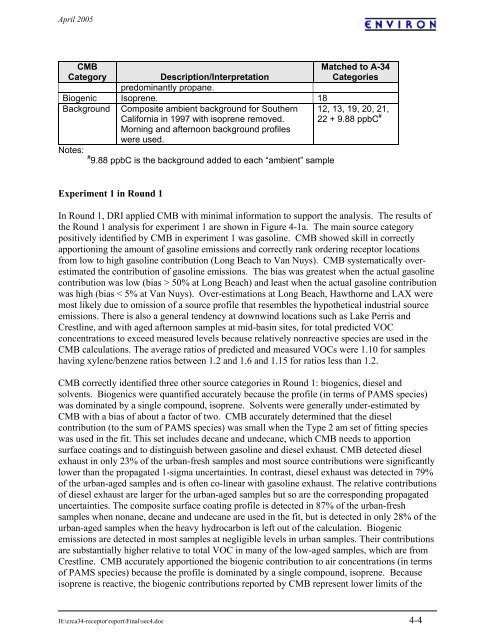CRC Report No. A-34 - Coordinating Research Council
CRC Report No. A-34 - Coordinating Research Council
CRC Report No. A-34 - Coordinating Research Council
You also want an ePaper? Increase the reach of your titles
YUMPU automatically turns print PDFs into web optimized ePapers that Google loves.
April 2005<br />
CMB<br />
Category<br />
Description/Interpretation<br />
predominantly propane.<br />
Biogenic Isoprene. 18<br />
Background Composite ambient background for Southern<br />
California in 1997 with isoprene removed.<br />
Morning and afternoon background profiles<br />
were used.<br />
<strong>No</strong>tes:<br />
# 9.88 ppbC is the background added to each “ambient” sample<br />
Matched to A-<strong>34</strong><br />
Categories<br />
12, 13, 19, 20, 21,<br />
22 + 9.88 ppbC #<br />
Experiment 1 in Round 1<br />
In Round 1, DRI applied CMB with minimal information to support the analysis. The results of<br />
the Round 1 analysis for experiment 1 are shown in Figure 4-1a. The main source category<br />
positively identified by CMB in experiment 1 was gasoline. CMB showed skill in correctly<br />
apportioning the amount of gasoline emissions and correctly rank ordering receptor locations<br />
from low to high gasoline contribution (Long Beach to Van Nuys). CMB systematically overestimated<br />
the contribution of gasoline emissions. The bias was greatest when the actual gasoline<br />
contribution was low (bias > 50% at Long Beach) and least when the actual gasoline contribution<br />
was high (bias < 5% at Van Nuys). Over-estimations at Long Beach, Hawthorne and LAX were<br />
most likely due to omission of a source profile that resembles the hypothetical industrial source<br />
emissions. There is also a general tendency at downwind locations such as Lake Perris and<br />
Crestline, and with aged afternoon samples at mid-basin sites, for total predicted VOC<br />
concentrations to exceed measured levels because relatively nonreactive species are used in the<br />
CMB calculations. The average ratios of predicted and measured VOCs were 1.10 for samples<br />
having xylene/benzene ratios between 1.2 and 1.6 and 1.15 for ratios less than 1.2.<br />
CMB correctly identified three other source categories in Round 1: biogenics, diesel and<br />
solvents. Biogenics were quantified accurately because the profile (in terms of PAMS species)<br />
was dominated by a single compound, isoprene. Solvents were generally under-estimated by<br />
CMB with a bias of about a factor of two. CMB accurately determined that the diesel<br />
contribution (to the sum of PAMS species) was small when the Type 2 am set of fitting species<br />
was used in the fit. This set includes decane and undecane, which CMB needs to apportion<br />
surface coatings and to distinguish between gasoline and diesel exhaust. CMB detected diesel<br />
exhaust in only 23% of the urban-fresh samples and most source contributions were significantly<br />
lower than the propagated 1-sigma uncertainties. In contrast, diesel exhaust was detected in 79%<br />
of the urban-aged samples and is often co-linear with gasoline exhaust. The relative contributions<br />
of diesel exhaust are larger for the urban-aged samples but so are the corresponding propagated<br />
uncertainties. The composite surface coating profile is detected in 87% of the urban-fresh<br />
samples when nonane, decane and undecane are used in the fit, but is detected in only 28% of the<br />
urban-aged samples when the heavy hydrocarbon is left out of the calculation. Biogenic<br />
emissions are detected in most samples at negligible levels in urban samples. Their contributions<br />
are substantially higher relative to total VOC in many of the low-aged samples, which are from<br />
Crestline. CMB accurately apportioned the biogenic contribution to air concentrations (in terms<br />
of PAMS species) because the profile is dominated by a single compound, isoprene. Because<br />
isoprene is reactive, the biogenic contributions reported by CMB represent lower limits of the<br />
H:\crca<strong>34</strong>-receptor\report\Final\sec4.doc 4-4
















